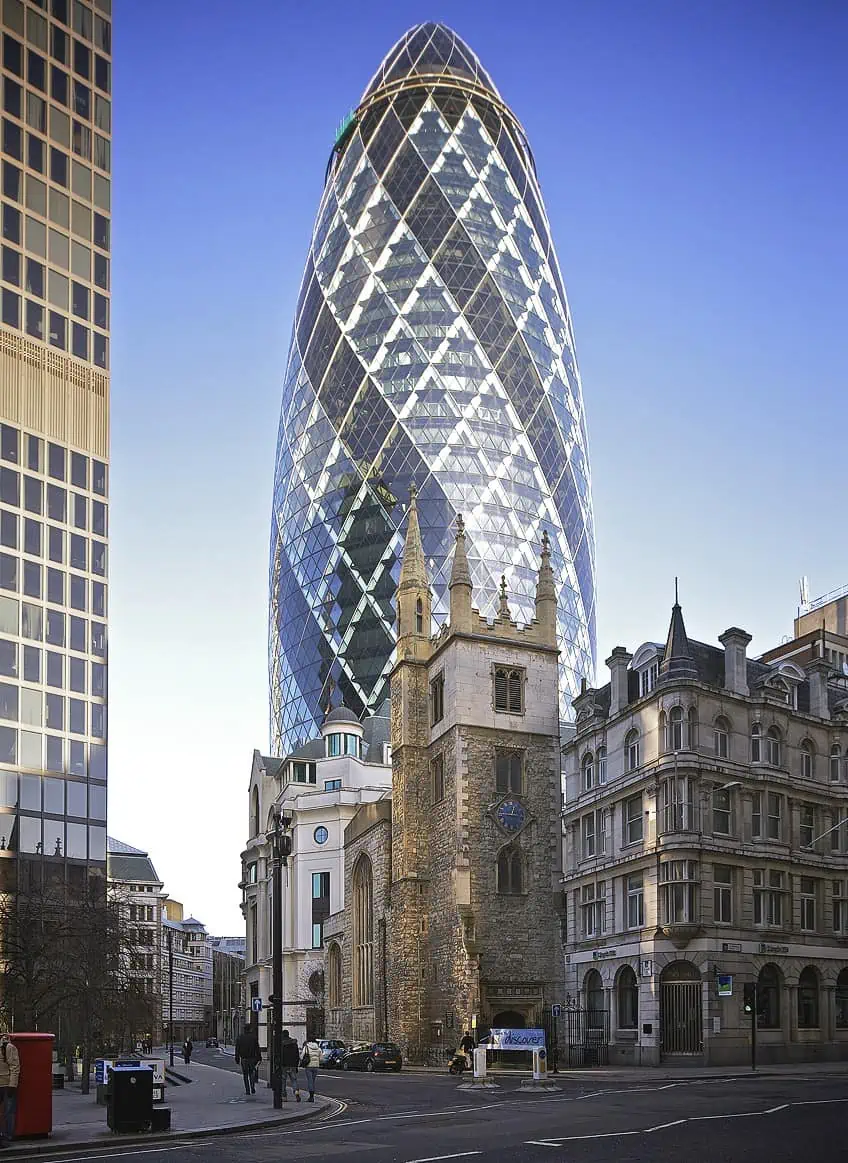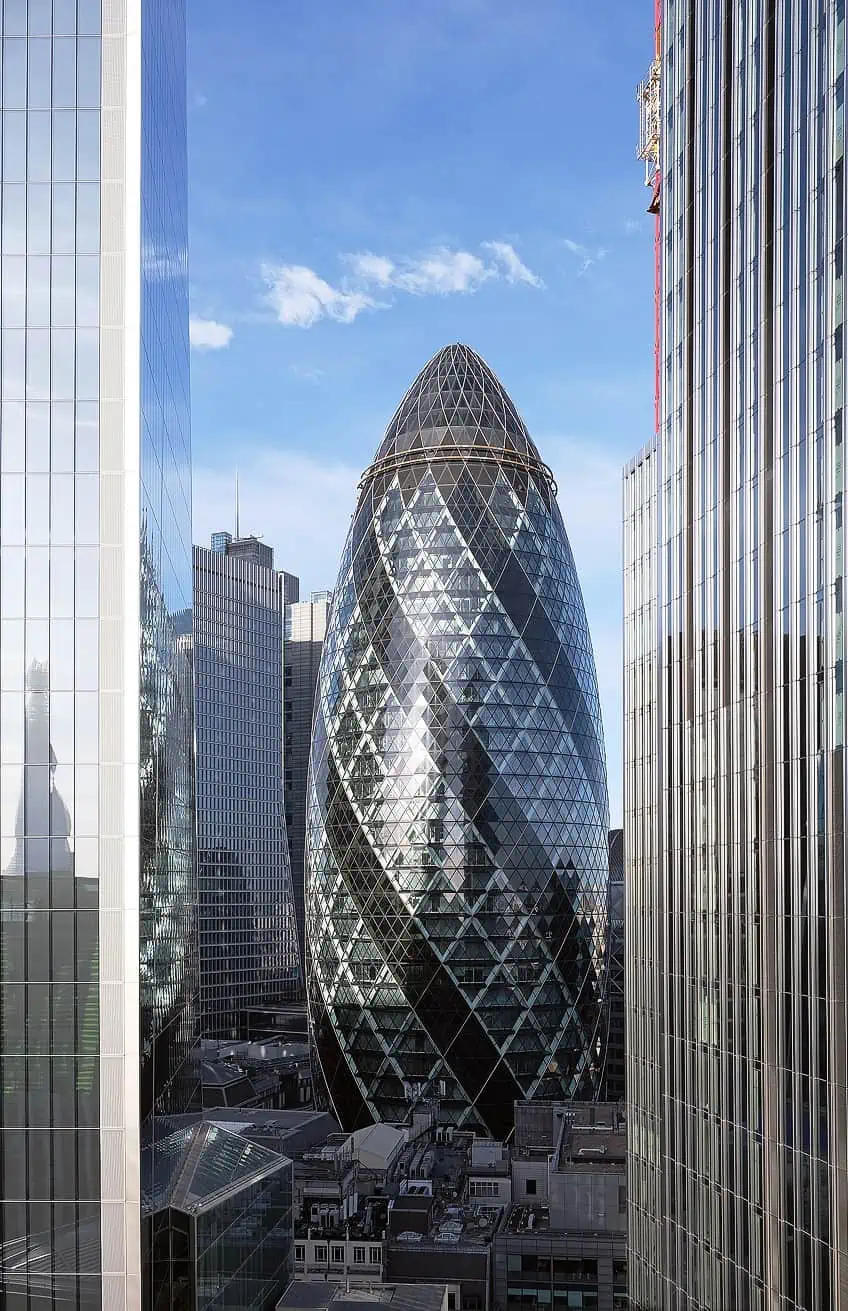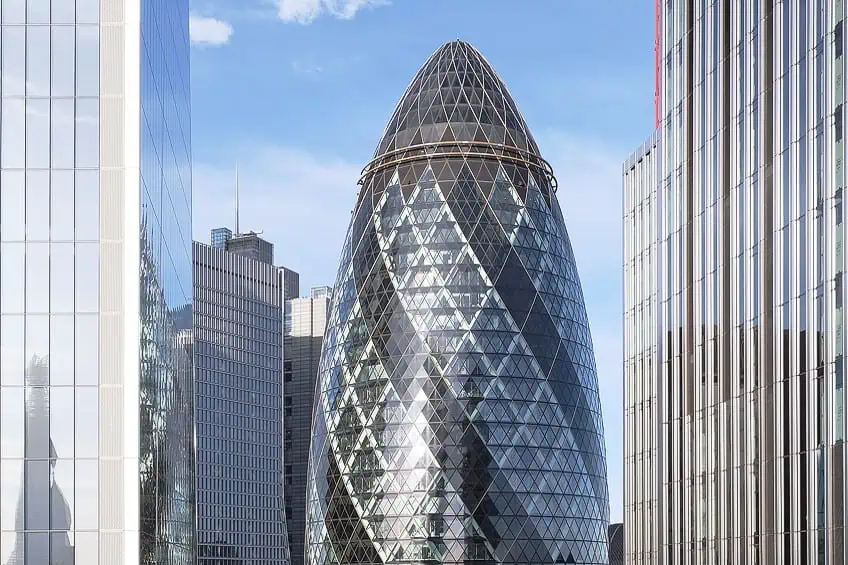The Gherkin in London – Interesting Facts About the Gherkin
The Gherkin in London is one of the most striking structures in the city. This egg-shaped building is a fascinating structure, and over the course of this article, we will discuss the Gherkin’s architecture, history, the architects behind it, and also a few additional facts that are worth knowing. Keep reading to learn more about the building located at 30 St Mary Axe, better known as the Gherkin.
A Look at the Gherkin in London
| Architect | Norman Foster (1935 – Present) and Foster + Partners |
| Date Constructed | 2001 – 2003 |
| Function | Office building |
| Materials Used | Steel, glass, and concrete |
| Height | 180 meters (or 591 ft) |
| Location | London, United Kingdom |
The Gherkin in London is one of the most unique-looking structures designed in the early 21st century. This name, which is a rather strange one, is not the official name of the structure. Instead, it is 30 St Mary Axe. This is the location of the Gherkin building as well as the actual name, although it used to be called the Swiss Re Building. However, whatever the people call a building, that tends to be what the building ends up being called. So, we will be predominantly referring to this building as the Gherkin in London throughout his article.
This egg-shaped building was completed at the very end of 2003 but only opened a few months later in 2004.

The structure is not particularly large at only 180 m (or 591 ft) with a floor count of 41, but the height of the structure is not what makes this building stand out. Instead, it stands out because of its peculiar architectural style. Additionally, the structure was predominantly designed by Lord Norman Foster, the most successful architect in the world. The original plan for the site was to build the Millennium Tower, which would have been stretched to a height of 92 stories, was scrapped. This laid the way for the Gherkin building which now stands as one of the most remarkable sights in the entirety of London. Its general visual presentation has turned it into one of the most significant structures in the city, and a unique structure that has come to represent contemporary architecture in the region.
The Gherkin’s History
The Gherkin in London only exists on the property on which it was constructed because the buildings that had been there before, the Baltic Exchange and the Chamber of Shipping, were practically destroyed in an IRA bombing. Because these buildings were partially destroyed, the area needed to be cleared away and reconstructed. Plans were soon underway to replace the now-damaged buildings with something new, and so 30 St Mary Axe became home to a new set of plans that would allow the nasty history to be left behind so that something new could be erected in its place. At first, there was a desire for the historic buildings that had been damaged to be restored, but, sadly, the damage was far more extensive than had at first been known. This led the English Heritage Foundation to stop with their attempts to restore the structure, although there were still many who wanted to retain the old buildings.
The remaining pieces of the interior of the original buildings were actually dismantled to allow for them to be preserved, and so they are not entirely gone despite the buildings themselves being demolished.
Once this was all over, there were plans to construct a far larger tower than the Gherkin building that currently stands on the site. This building, known as the Millennium Tower, would have been far larger. However, there was a backlash to the scale of the building, and thanks to the height, it may have disrupted the air traffic of the nearby airports. This led to them deciding that something else would have to go in its place.

The planning of the Gherkin building had officially begun. These plans started out as an attempt to simply reconstruct the Baltic Exchange with a new and more traditionally designed structure that would have been rectangular in design. However, there were calls for building something different, and this was when Foster + Partners received the job to design this new building at 30 St Mary Axe. These new plans would lead to the development of the egg-shaped building that now stands in this spot, and long before the building was ever finished construction, people had taken to calling it “the Gherkin”. The Gherkin in London was soon designed and constructed, and it quickly became one of the most unique structures in the city.
However, the Baltic Exchange instead moved its offices to a different location in London rather than retaining its position at this new location. The Gherkin in London would become a notable structure without this famous organization within its walls though, and it currently stands as a financially successful office building.
The Gherkin’s Architecture
The Gherkin in London is a building that does not necessarily conform to any singular style. Instead, it has been described in a variety of ways. It is seen as Neo-Futuristic, which is especially applicable, and an example of high-tech architecture (which is also applicable as the architect is considered to be one of the most notable proponents of high-tech architecture in the world). Furthermore, parts of the construction are often compared to Modernist architecture. The most obvious architectural feature related to the Gherkin building is its shape. The building makes use of an oval shape that is often described as “egg-shaped”. It is also often compared to a gherkin, hence the name. This is a kind of pickled cucumber, like a pickle. So, even though the building is actually called 30 St Mary Axe, the name “the Gherkin” has stuck around because of the basic design of the building as a whole.

One of the other most notable elements about the design of the structure as a whole is the use of sustainable elements. The building makes use of energy-saving technologies to reduce the amount of electricity that is needed, but there are also other methods that are used. For instance, there is a natural ventilation system that is implemented through the use of special gaps between each floor of the building. This is a form of double glazing and is a commonly used technique in residences (albeit on a far larger scale with regards to this skyscraper). Additionally, the building was designed with a bar and observation area at the top of the building for the various tenants of the structure. This location allows for panoramic views of the city, and it simply serves as a pleasant space away from the hubbub of the office space that occupies the rest of the building.
The Gherkin’s Architect and Firm
The primary architect behind the Gherkin in London is Norman Foster. This British architect is the richest and most successful architect in the world. He is particularly noted as a proponent of high-tech architecture and has been involved in some of the most notable structures of the late-20th and early 21st centuries. He has achieved immense acclaim throughout his career (including being knighted), been awarded numerous prizes, and has become a central figure in the promotion of architecture as a whole. However, while Norman Foster is the Gherkin’s architect, the architectural firm that also contributed to the design of the building was Foster + Partners, Norman Foster’s architectural firm.
Foster + Partners is a massive firm that is headquartered in London, United Kingdom, but it has designed buildings throughout the world. Some of the most famous, aside from the Gherkin in London, have included the Hearst Tower in New York City and the Reichstag building in Berlin.
This company, much like the man after whom it is named, has won numerous accolades and is considered to be one of the best architectural firms in the world. The architectural might of both Norman Foster himself and his architectural firm led to the Gherkin in London becoming one of the most unique structures in the city and, perhaps, in the world. They would go on to create many more buildings around the world, but the Gherkin building certainly is one of the most unique.
The Gherkin Facts and Interesting Tidbits
The Gherkin in London is a particularly famous London landmark, and it has attained this status for a very good reason. Let’s look at some of the most interesting Gherkin facts and interesting extras:
- During construction, a body was found. The body was dated at about 1600 years old, and after the construction of the building, her body was re-buried in the same location with an inscription to mark it.
- The Gherkin has won numerous awards. The building was considered an instant classic as soon as it was constructed, and it even won the Stirling Prize in 2004. It was even the first time in the history of the award that all the judges agreed with one another in their decision.
- A glass panel once fell from the building. This occurred in April 2005, and while there were a few safety measures added for a while, the building was ultimately deemed to be safe after extensive testing.
- Jeff Randall Live is broadcast from the building. This Sky News business program has been broadcast from the studio ever since 2010.
- The Gherkin has been used in many films. It has appeared in movies like Harry Potter and the Half-Blood Prince and Match Point.
These have been only a few extra tidbits of information about this famous London building. The Gherkin’s facts and extra tidbits are likely far more numerous, but one could always learn a lot more about any structure.

We have arrived at the end of our discussion about the Gherkin in London. We have examined the Gherkin building’s history, architecture, architects, and the various Gherkin facts. Hopefully, you have learned a lot about this strangely nicknamed building today. There are other strangely-named places out there, and many of them are worth a look!
Frequently Asked Questions
What Is the Gherkin?
The Gherkin building is a skyscraper in London, the United Kingdom. This name is not the official name of the building, as it is actually called 30 St Mary Axe, but residents have been calling it the Gherkin building since before it was even finished construction. The building has become a London landmark and is considered to be one of the greatest instances of contemporary architecture in the world.
Where Is the Gherkin Located?
The Gherkin building is located in London. But where is the Gherkin located in more specific terms? The building is technically situated in the City of London, which is the central part of London as a whole. Specifically, it is located at 30 St Mary Axe, which is found in the city’s central business district. This means that the Gherkin in London is central and therefore one of the most notable aspects of the London skyline.
What Is the Gherkin’s Architecture and Style?
The Gherkin in London is a high-tech building, in keeping with the kinds of buildings for which Norman Foster is known, but it is otherwise noted for being a Neo-Futurist and Modernist structure. The unusual egg-shaped design has been noted as one of the most unique skyscraper designs of the early 21st century, and it has gone on to be considered an immensely innovative and sustainable structure.
Who Is the Gherkin’s Architect?
The Gherkin’s architect is Norman Foster. However, he also worked alongside the company that he founded, Foster + Partners, when designing 30 St Mary Axe. He is a noted architect in the high-tech architectural style and is also the most successful architect alive. He was even knighted for his architectural services to the world.
What Is Significant About the Gherkin?
The most significant aspect about the Gherkin’s architecture is its shape and appearance. The egg-shaped building with its glass façade has become an iconic structure in London. It has also been hailed as one of the most innovative contemporary buildings in the world because of the sustainability factors designed into the structure which have since become commonplace but were, at the time, innovations.
Justin van Huyssteen is a writer, academic, and educator from Cape Town, South Africa. He holds a master’s degree in Theory of Literature. His primary focus in this field is the analysis of artistic objects through a number of theoretical lenses. His predominant theoretical areas of interest include narratology and critical theory in general, with a particular focus on animal studies. Other than academia, he is a novelist, game reviewer, and freelance writer. Justin’s preferred architectural movements include the more modern and postmodern types of architecture, such as Bauhaus, Art Nouveau, Art Deco, Brutalist, and Futurist varieties like sustainable architecture. Justin is working for artfilemagazine as an author and content writer since 2022. He is responsible for all blog posts about architecture.
Learn more about Justin van Huyssteen and about us.
Cite this Article
Justin, van Huyssteen, “The Gherkin in London – Interesting Facts About the Gherkin.” artfilemagazine – Your Online Art Source. June 15, 2023. URL: https://artfilemagazine.com/the-gherkin-in-london/
van Huyssteen, J. (2023, 15 June). The Gherkin in London – Interesting Facts About the Gherkin. artfilemagazine – Your Online Art Source. https://artfilemagazine.com/the-gherkin-in-london/
van Huyssteen, Justin. “The Gherkin in London – Interesting Facts About the Gherkin.” artfilemagazine – Your Online Art Source, June 15, 2023. https://artfilemagazine.com/the-gherkin-in-london/.



